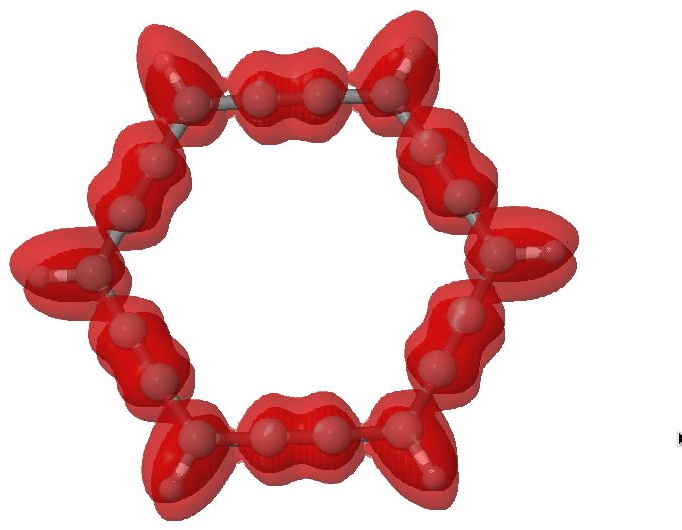Some molecules, when you first see them, just intrigue. So it was with carbobenzene, the synthesis of a derivative of which was recently achieved by Remi Chauvin and co-workers (DOI: 10.1002/chem.200601193). Two additional carbon atoms have been inserted into each of the six C-C bonds in benzene.
The structure shows two resonance forms, which remind one of Kekulé and of course benzene itself. Counting reveals 18π-electrons in the conventional π sense, but with a further set of 12 π-electrons located in the plane of the ring, and orthogonal to the first set. Since both could be cyclically conjugated, we can say that the first set belongs to a 4n+2 count, and should set up diatropic ring currents resulting in aromaticity, whilst the second set would belong to the 4n category, and might set up paratropic ring currents in the plane of the system. The lowest occupied molecular orbitals of each set look as follows.
 The lowest MO for the 18π-electron set. Click for 3D |
 Lowest occupied molecular orbital for the 12π-electron set. Click for 3D |
Experimentally, the molecule is found to be aromatic. One way of quantifying this is via the so-called dissected NICS magnetic response index (DOI: 10.1021/ol016217v). At the ring centroid, NICS(0,1,2,3)zz (respectively 0,1,2,3Å above the plane of the ring) are found to be -49, -46, -38 and -28 ppm (DOI: http://10042/to-4878). The un-dissected NICS (which includes all σ-current contributions) were -18, -16.6, -13 and -9 ppm. This both confirms diatropicity (for which NICS is strongly negative) and also suggests that the 12-electron π-framework is opposing the 18-electron π-framework.
Another, less common way to study the aromaticity is to look at the delocalization of the electrons using the ELF technique.
 ELF function evaluated using only the 18 π electrons. Click for 3D |
–
 ELF function evaluated using only the 12 σ-electrons. Click for 3D |
The 18-electron set bifurcate (break up into smaller basins), at the threshold of 0.87 shown above (the ELF function has a maximum of 1.0 and a minimum of 0.0), a high value which is typical of aromatic systems (benzene bifurcates at ~0.9). In contrast, the 12-electron set break up well before a value of 0.1 (shown), a low value which tends to indicate anti-aromaticity.
There are many other ways of exploring the properties of such aromatic molecules, but the two above tend to suggest that carbobenzene has two personalities, one aromatic, the other antiaromatic, and with the former dominant. This gives it an interesting twist on benzene itself, and makes one wonder whether this dual Janus-like personality could be exploited in some interesting fashion.
Tags: aromatic systems, General, http, Missouri, Remi Chauvin



Cool molecule! Had to file it in ChemPedia.com (4-7135-0982-8245)
@Egon, I had to find out if that was for real. Did a Google search for ‘carbobenzene’ in Google, and this article came up first!
@Henry, I’ve been reading for awhile – great stuff. Feel free to post a link to your blog here.
Wow, what an amazing extension of the benzene molecule!
Do you know whether there are even bigger extensions– for instance, by adding more carbon atoms to each side?
Just recently, carbo-naphthalene has been reported. This too is reported to have a strong diatropic ring current. DOI: 10.1002/anie.201608300 The 3D structure can be inspected at DOI: 10.5517/ccdc.csd.cc1k22qf.